2019 HYUNDAI ELANTRA SPORT engine
[x] Cancel search: enginePage 512 of 534
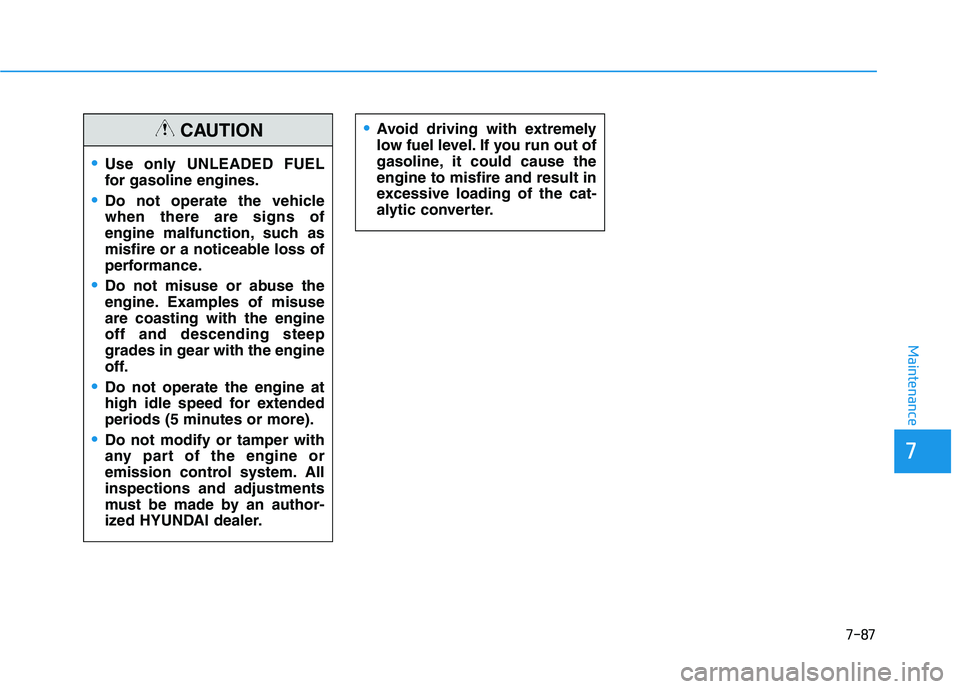
7-87
7
Maintenance
Use only UNLEADED FUEL
for gasoline engines.
Do not operate the vehicle when there are signs of
engine malfunction, such as
misfire or a noticeable loss of
performance.
Do not misuse or abuse the
engine. Examples of misuseare coasting with the engineoff and descending steep
grades in gear with the engine
off.
Do not operate the engine at
high idle speed for extended
periods (5 minutes or more).
Do not modify or tamper with
any part of the engine or
emission control system. Allinspections and adjustments
must be made by an author-
ized HYUNDAI dealer.
Avoid driving with extremely
low fuel level. If you run out of
gasoline, it could cause theengine to misfire and result in
excessive loading of the cat-
alytic converter.CAUTION
Page 513 of 534
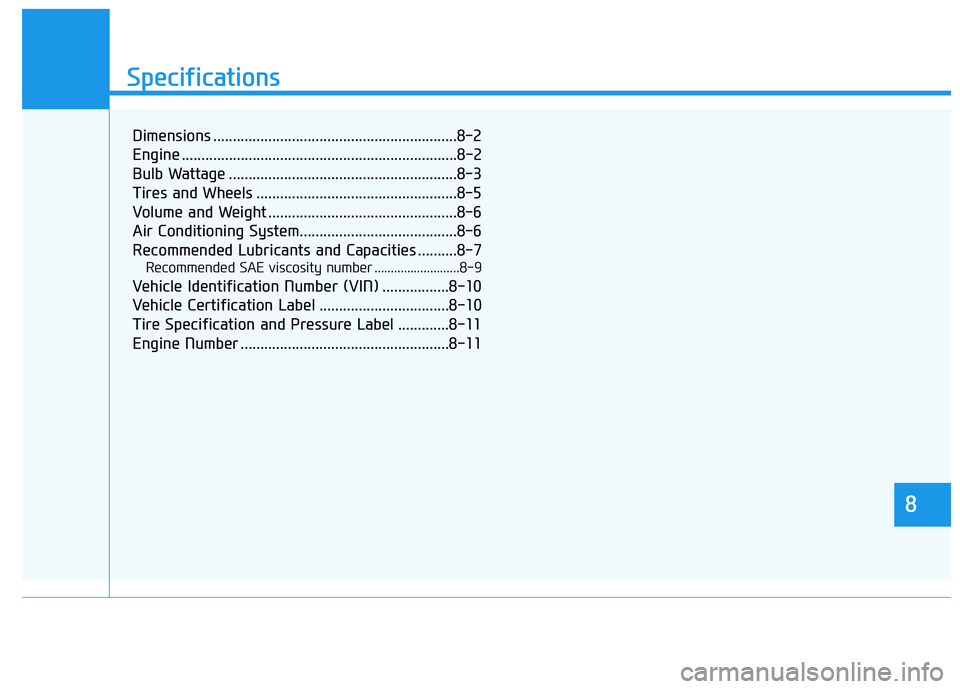
888
Specifications & Consumer information
8
Specifications
8
Dimensions ..............................................................8-2
Engine ......................................................................8-2
Bulb Wattage ..........................................................8-3
Tires and Wheels ...................................................8-5
Volume and Weight ................................................8-6
Air Conditioning System........................................8-6
Recommended Lubricants and Capacities ..........8-7Recommended SAE viscosity number ..........................8-9
Vehicle Identification Number (VIN) .................8-10
Vehicle Certification Label .................................8-10
Tire Specification and Pressure Label .............8-11
Engine Number .....................................................8-11
Page 519 of 534
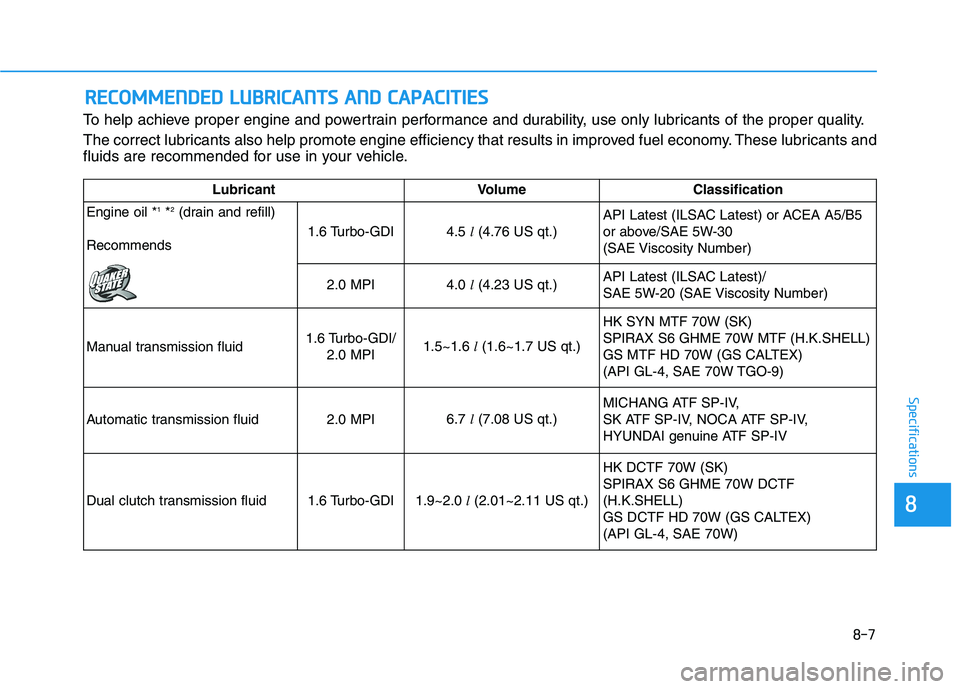
8-7
88
Specifications
To help achieve proper engine and powertrain performance and durability, use only lubricants of the proper quality.
The correct lubricants also help promote engine efficiency that results in improved fuel economy. These lubricants and
fluids are recommended for use in your vehicle.
RREECCOO MM MMEENN DDEEDD LL UU BBRRIICC AA NN TTSS AA NN DD CC AA PPAA CCIITT IIEE SS
LubricantVolume Classification
Engine oil * 1
*2
(drain and refill)
Recommends
1.6 Turbo-GDI4.5 l(4.76 US qt.) API Latest (ILSAC Latest) or ACEA A5/B5
or above/SAE 5W-30
(SAE Viscosity Number)
2.0 MPI4.0
l(4.23 US qt.) API Latest (ILSAC Latest)/
SAE 5W-20 (SAE Viscosity Number)
Manual transmission fluid
1.6 Turbo-GDI/ 2.0 MPI1.5~1.6 l(1.6~1.7 US qt.) HK SYN MTF 70W (SK) SPIRAX S6 GHME 70W MTF (H.K.SHELL)
GS MTF HD 70W (GS CALTEX)
(API GL-4, SAE 70W TGO-9)
Automatic transmission fluid2.0 MPI6.7
l(7.08 US qt.)
MICHANG ATF SP-IV,
SK ATF SP-IV, NOCA ATF SP-IV,
HYUNDAI genuine ATF SP-IV
Dual clutch transmission fluid1.6 Turbo-GDI1.9~2.0 l(2.01~2.11 US qt.)
HK DCTF 70W (SK) SPIRAX S6 GHME 70W DCTF(H.K.SHELL)
GS DCTF HD 70W (GS CALTEX)(API GL-4, SAE 70W)
Page 520 of 534
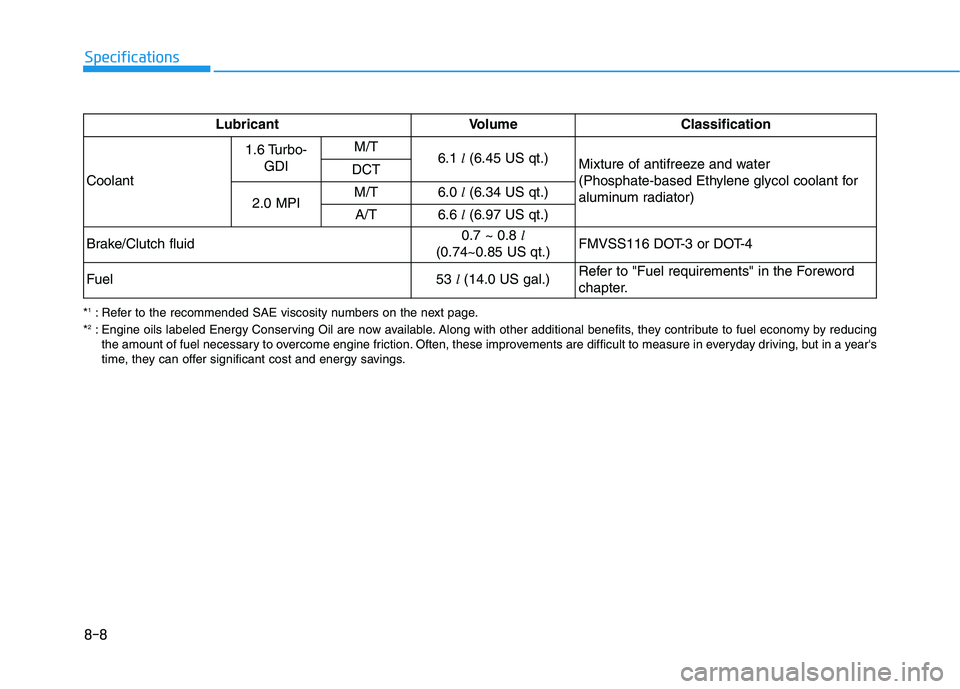
8-8
Specifications
*1
: Refer to the recommended SAE viscosity numbers on the next page.
* 2
: Engine oils labeled Energy Conserving Oil are now available. Along with other additional benefits, they contribute to fuel economy by reducing
the amount of fuel necessary to overcome engine friction. Often, these improvements are difficult to measure in everyday driving, but in a year's
time, they can offer significant cost and energy savings. Lubricant
Volume Classification
Coolant 1.6 Turbo-
GDI M/T
6.1
l(6.45 US qt.)
Mixture of antifreeze and water
(Phosphate-based Ethylene glycol coolant for
aluminum radiator)
DCT
2.0 MPI M/T
6.0
l(6.34 US qt.)
A/T
6.6 l(6.97 US qt.)
Brake/Clutch fluid
0.7 ~ 0.8 l
(0.74~0.85 US qt.) FMVSS116 DOT-3 or DOT-4
Fuel53
l(14.0 US gal.)Refer to "Fuel requirements" in the Foreword
chapter.
Page 521 of 534
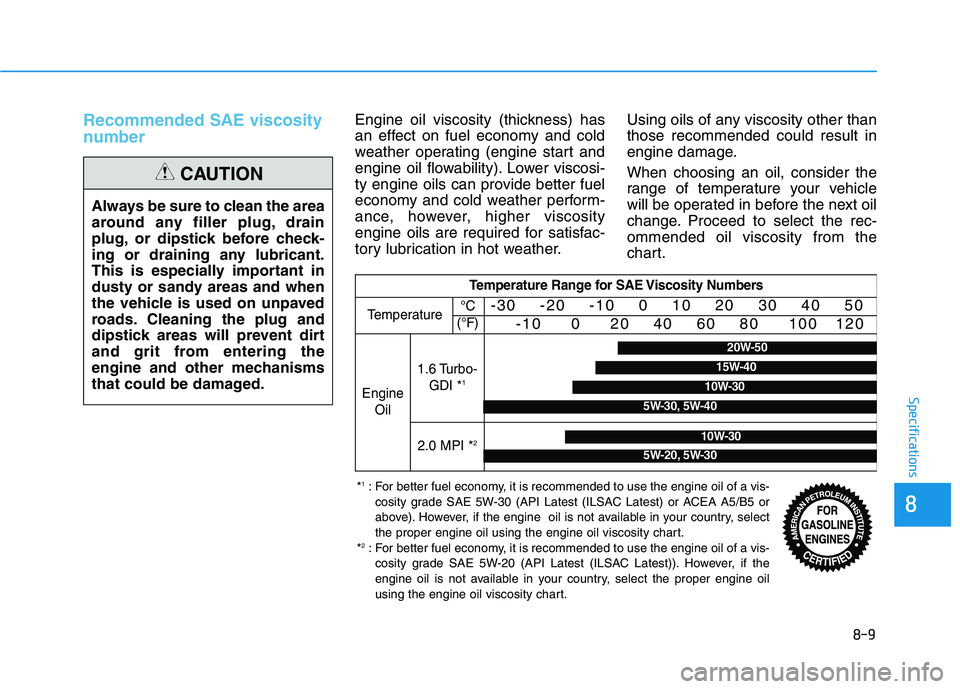
8-9
88
Specifications
Recommended SAE viscosity
number Engine oil viscosity (thickness) has
an effect on fuel economy and cold
weather operating (engine start and
engine oil flowability). Lower viscosi-
ty engine oils can provide better fuel
economy and cold weather perform-
ance, however, higher viscosity
engine oils are required for satisfac-
tory lubrication in hot weather.Using oils of any viscosity other thanthose recommended could result in
engine damage. When choosing an oil, consider the
range of temperature your vehicle
will be operated in before the next oil
change. Proceed to select the rec-ommended oil viscosity from the
chart.
Always be sure to clean the area
around any filler plug, drain
plug, or dipstick before check-
ing or draining any lubricant.
This is especially important in
dusty or sandy areas and when
the vehicle is used on unpaved
roads. Cleaning the plug and
dipstick areas will prevent dirt
and grit from entering the
engine and other mechanisms
that could be damaged.
CAUTION
Temperature Range for SAE Viscosity Numbers
Temperature -30 -20 -10 0 10 20 30 40 50
-10 0 20 40 60 80 100 120
Engine
Oil
1.6 Turbo-GDI * 1
2.0 MPI * 2
°C
(°F)
* 1
: For better fuel economy, it is recommended to use the engine oil of a vis-
cosity grade SAE 5W-30 (API Latest (ILSAC Latest) or ACEA A5/B5 or
above). However, if the engine oil is not available in your country, select
the proper engine oil using the engine oil viscosity chart.
* 2
: For better fuel economy, it is recommended to use the engine oil of a vis-
cosity grade SAE 5W-20 (API Latest (ILSAC Latest)). However, if the
engine oil is not available in your country, select the proper engine oil
using the engine oil viscosity chart.
5W-30, 5W-40
10W-30
15W-40
20W-50
10W-30
5W-20, 5W-30
Page 523 of 534

8-11
88
Specifications
The tires supplied on your new vehi-
cle are chosen to provide the best
performance for normal driving.
The tire label located on the driver’s
side center pillar gives the tire pres-
sures recommended for your car.The engine number is stamped on
the engine block as shown in the
drawing.
EENN GGIINN EE NN UU MM BBEERR
TT IIRR EE SS PP EECCIIFF IICC AA TTIIOO NN AA NN DD
P
P RR EESSSS UU RREE LL AA BBEELL
OAD085011N
OAD086012
■ 1.6 Turbo-GDI
OAD085009L
■2.0 MPI
Page 527 of 534

I-4
Defroster........................................................................3-118
Rear Window Defroster ............................................3-118
Dimensions .......................................................................8-2
Door Locks .....................................................................3-14 Auto Door Lock/Unlock Features ..............................3-17
Child-Protector Rear Door locks................................3-18
Operating Door Locks from Inside the Vehicle .........3-15
Operating Door Locks from Outside the Vehicle ......3-14
Safe Exit Assist (SEA) System ..................................3-18
Drive Mode Integrated Control System .........................5-52
Driver Assist System .....................................................3-114 Parking Distance Warning (Reverse) System ..........3-115
Rear View Monitor ...................................................3-114
Driver Attention Warning (DAW) system ....................5-110
Resetting the System ................................................5-111
System Malfunction..................................................5-112
System Setting and Activation .................................5-110
System Standby ........................................................5-112
Driver Position Memory System ....................................3-20 Easy Access Function .................................................3-22
Recalling positions from memory ..............................3-21
Resetting the Driver's Seat Memory System .............3-21
Storing Positions into Memory ..................................3-20
Driver's front air bag .......................................................2-45
Driver's knee air bag .......................................................2-45 Dual Clutch Transmission...............................................5-26
Dual clutch transmission operation ............................5-26
Good Driving Practices ..............................................5-38
LCD display for transmission temperature and warning message .....................................................5-28
Electric Power Steering (EPS) ........................................3-23
Electronic Stability Control (ESC) .................................5-45
Emission Control System ...............................................7-84 Crankcase Emission Control System .........................7-84
Evaporative Emission Control System Including Onboard Refueling Vapor Recovery (ORVR) ........7-84
Exhaust Emission Control System .............................7-85
Engine ...............................................................................8-2
Engine Compartment.................................................1-6, 7-3
Engine Coolant ...............................................................7-23 Changing Engine Coolant ..........................................7-26
Checking the Engine Coolant Level ..........................7-23
Engine Number ...............................................................8-11
Engine Oil .......................................................................7-21 Checking the Engine Oil and Filter ...........................7-22
Checking the Engine Oil Level ..................................7-21
Engine Start/Stop Button ..................................................5-9
Explanation of Scheduled Maintenance Items ...............7-18
Exterior Care ...................................................................7-76
Index
D
E
Page 528 of 534
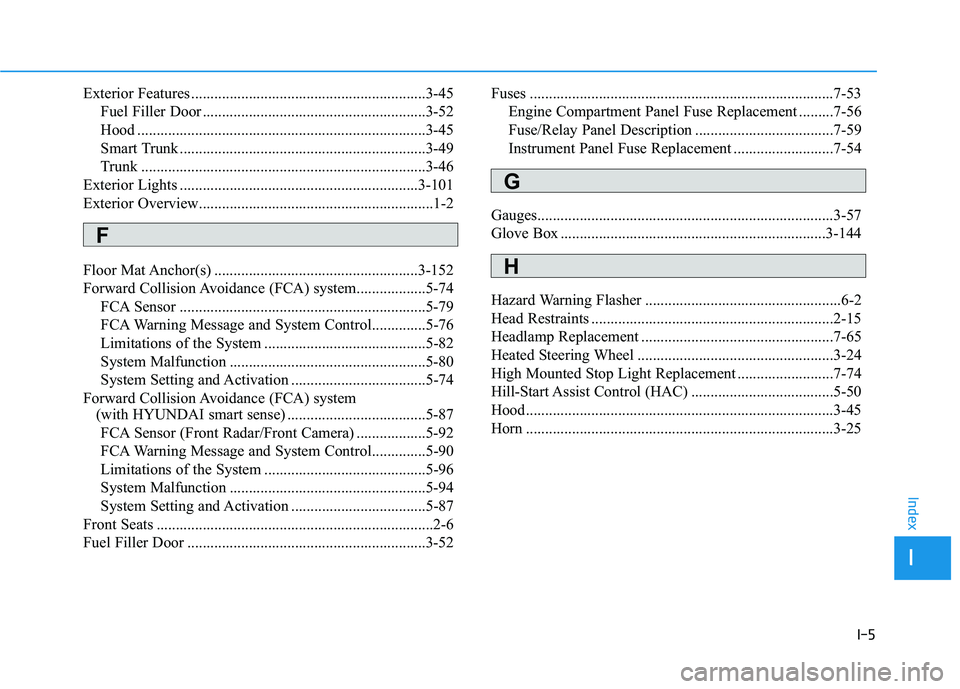
I-5
Exterior Features .............................................................3-45
Fuel Filler Door ..........................................................3-52
Hood ...........................................................................3-45
Smart Trunk ................................................................3-49
Trunk ..........................................................................3-46
Exterior Lights ..............................................................3-101
Exterior Overview.............................................................1-2
Floor Mat Anchor(s) .....................................................3-152
Forward Collision Avoidance (FCA) system..................5-74 FCA Sensor ................................................................5-79
FCA Warning Message and System Control..............5-76
Limitations of the System ..........................................5-82
System Malfunction ...................................................5-80
System Setting and Activation ...................................5-74
Forward Collision Avoidance (FCA) system (with HYUNDAI smart sense) ....................................5-87
FCA Sensor (Front Radar/Front Camera) ..................5-92
FCA Warning Message and System Control..............5-90
Limitations of the System ..........................................5-96
System Malfunction ...................................................5-94
System Setting and Activation ...................................5-87
Front Seats ........................................................................2-6
Fuel Filler Door ..............................................................3-52 Fuses ...............................................................................7-53
Engine Compartment Panel Fuse Replacement .........7-56
Fuse/Relay Panel Description ....................................7-59
Instrument Panel Fuse Replacement ..........................7-54
Gauges.............................................................................3-57
Glove Box .....................................................................3-144
Hazard Warning Flasher ...................................................6-2
Head Restraints ...............................................................2-15
Headlamp Replacement ..................................................7-65
Heated Steering Wheel ...................................................3-24
High Mounted Stop Light Replacement .........................7-74
Hill-Start Assist Control (HAC) .....................................5-50
Hood................................................................................3-45
Horn ................................................................................3-25
I
Index
F
G
H